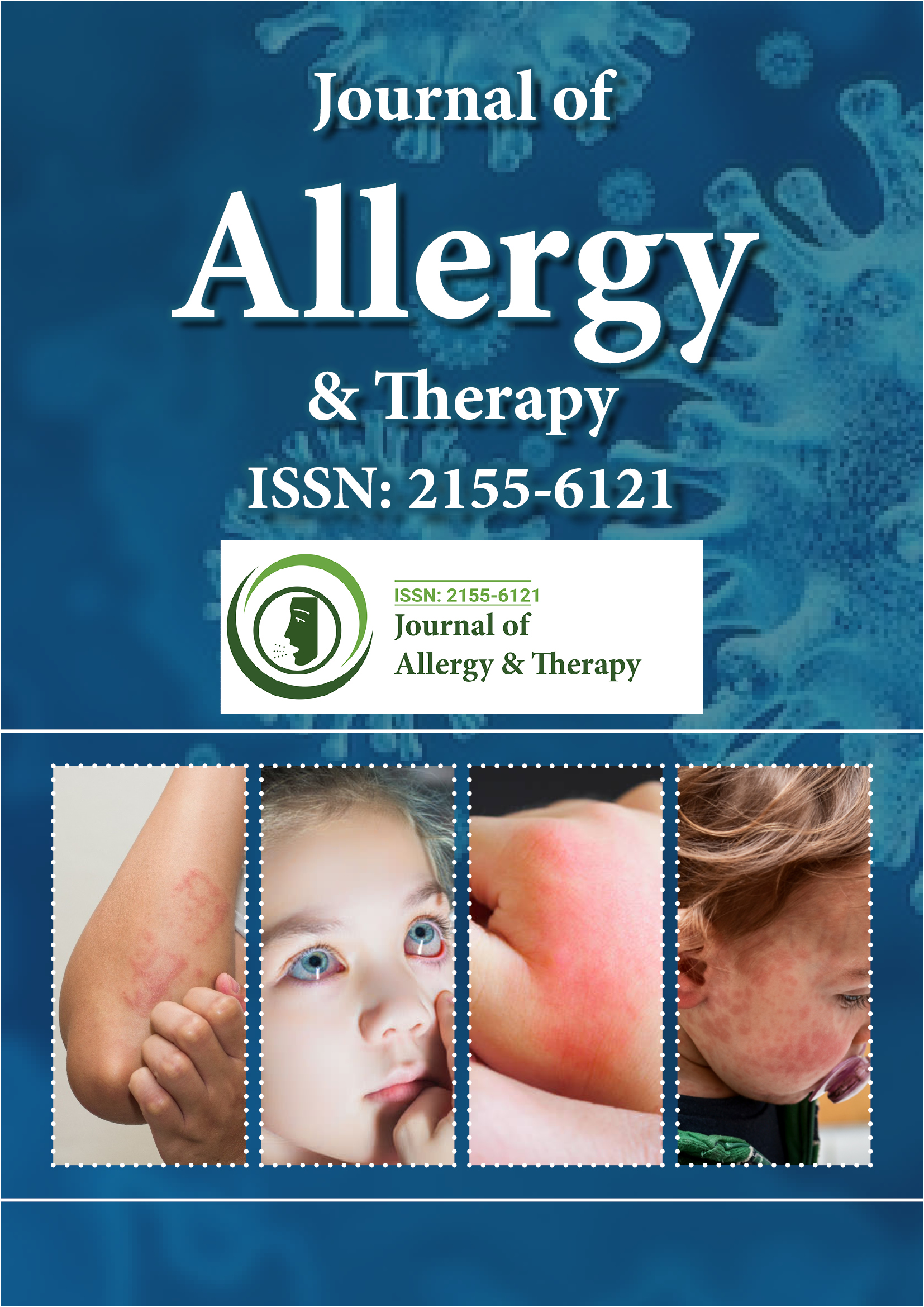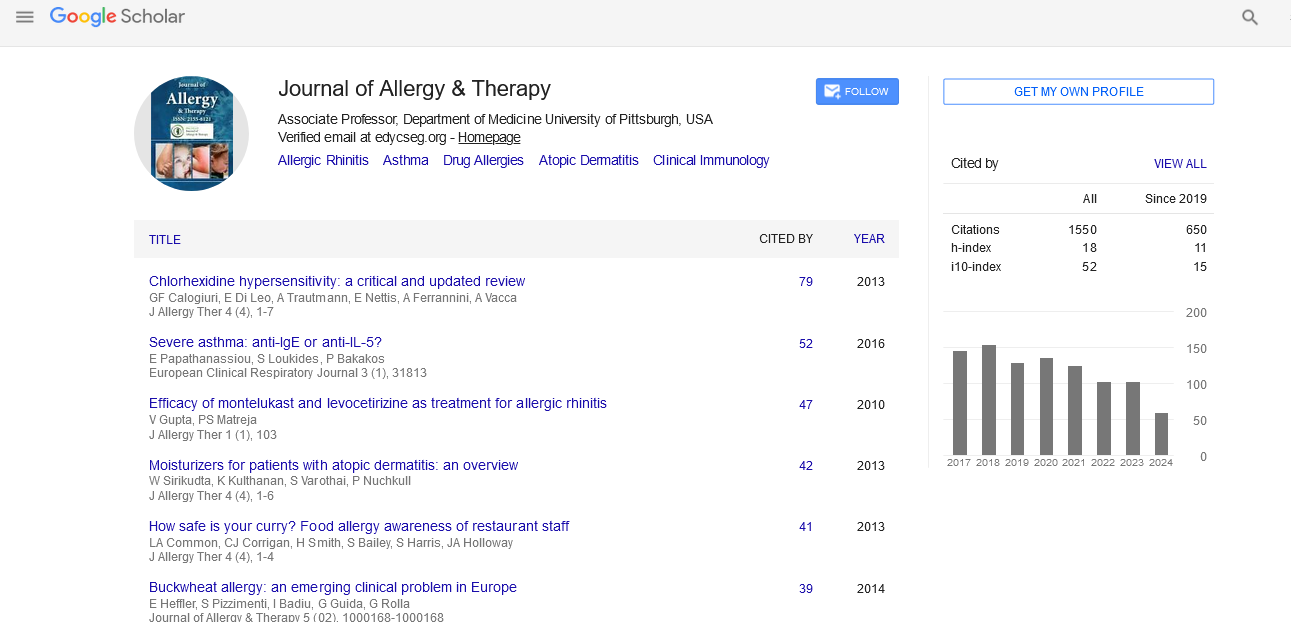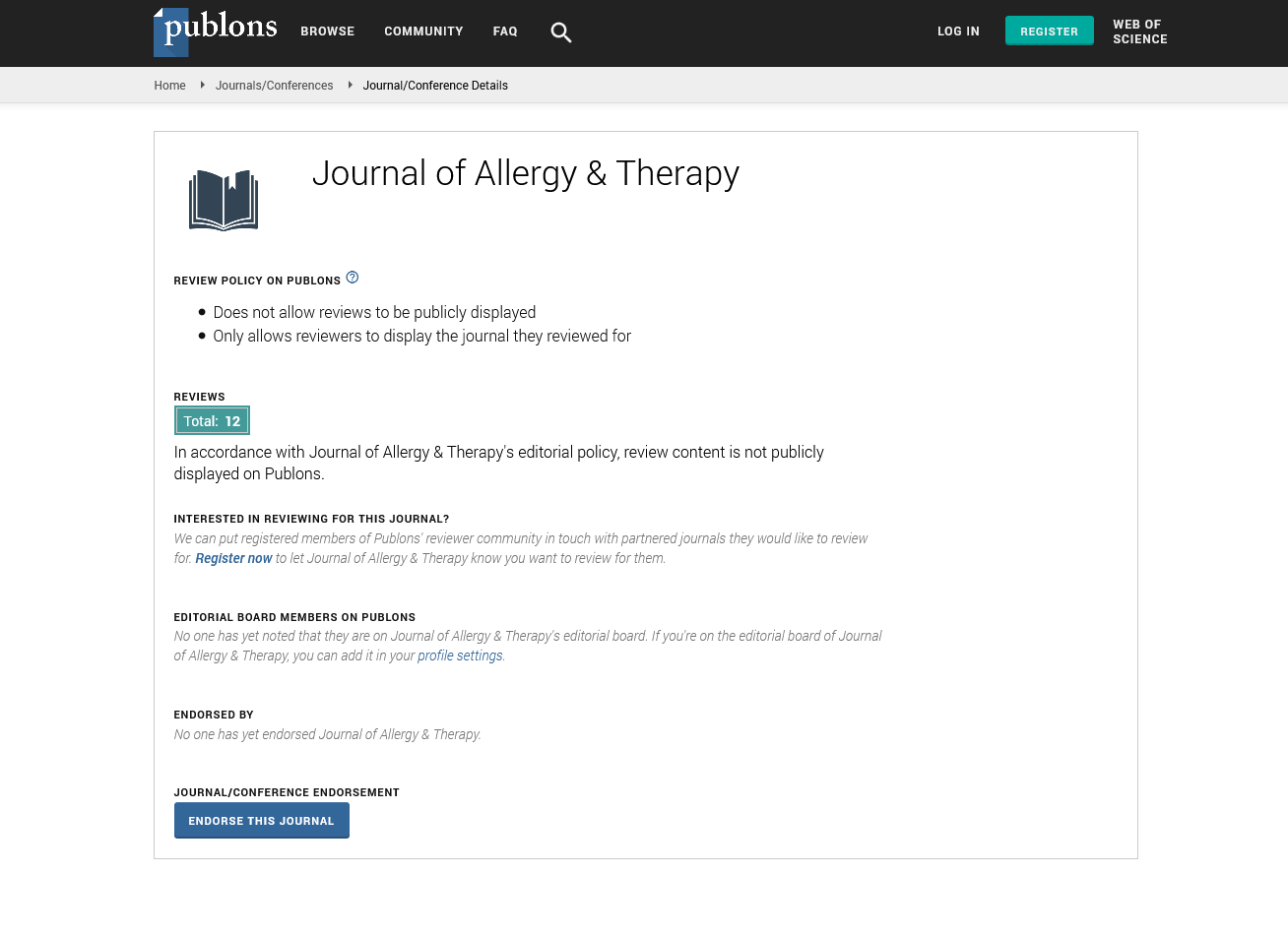Indexed In
- Academic Journals Database
- Open J Gate
- Genamics JournalSeek
- Academic Keys
- JournalTOCs
- China National Knowledge Infrastructure (CNKI)
- Ulrich's Periodicals Directory
- Electronic Journals Library
- RefSeek
- Hamdard University
- EBSCO A-Z
- OCLC- WorldCat
- SWB online catalog
- Virtual Library of Biology (vifabio)
- Publons
- Geneva Foundation for Medical Education and Research
- Euro Pub
- Google Scholar
Useful Links
Share This Page
Journal Flyer

Open Access Journals
- Agri and Aquaculture
- Biochemistry
- Bioinformatics & Systems Biology
- Business & Management
- Chemistry
- Clinical Sciences
- Engineering
- Food & Nutrition
- General Science
- Genetics & Molecular Biology
- Immunology & Microbiology
- Medical Sciences
- Neuroscience & Psychology
- Nursing & Health Care
- Pharmaceutical Sciences
Perspective - (2023) Volume 14, Issue 4
Advantages and Challenges of the Revolutionising Impact of Nanotechnology on Allergy Treatment
Neeland Namiki*Received: 28-Jul-2023, Manuscript No. JAT-23-23056 ; Editor assigned: 01-Aug-2023, Pre QC No. JAT-23-23056 (PQ); Reviewed: 18-Aug-2023, QC No. JAT-23-23056 ; Revised: 25-Aug-2023, Manuscript No. JAT-23-23056 (R); Published: 01-Sep-2023, DOI: 10.35248/2156-6121.23.14.355
Description
Nanotechnology, the science of manipulating materials at the nanoscale, has emerged as a powerful tool in various fields, including medicine. In recent years, nanotechnology has shown immense potential in revolutionizing the way we diagnose, treat, and manage allergies. Allergies, ranging from seasonal hay fever to life-threatening food allergies, affect millions of people worldwide. Traditional allergy treatments often rely on medications that alleviate symptoms but don't address the underlying causes. Nanotechnology offers innovative approaches that can provide more precise and effective allergy treatment, bringing hope to allergy sufferers.
Understanding nanotechnology
Nanotechnology operates at the nanometer scale, where one nanometer is equal to one billionth of a meter. At this tiny scale, materials exhibit unique properties and behaviors that differ from their bulk counterparts. Researchers harness these properties to design and create nanomaterials for various applications. In the context of allergy treatment, nanotechnology offers several advantages.
Targeted delivery: Nanoparticles can be engineered to carry drugs, allergens, or therapeutic agents directly to the affected tissues or cells. This precision reduces side effects and enhances treatment efficacy.
Enhanced solubility: Many drugs used in allergy treatment have limited solubility, making them less effective. Nanoparticles can improve solubility, ensuring that the drug is efficiently delivered to the desired site.
Immune system modulation: Nanoparticles can interact with the immune system, modulating its responses. This property is particularly valuable in allergies, where the immune system overreacts to harmless substances.
Sustained release: Nanotechnology allows for the controlled release of therapeutic agents over time, reducing the need for frequent dosing and improving patient compliance.
Key applications of nanotechnology in allergy treatment
Nanoparticle-based allergen delivery: One of the primary challenges in treating allergies is allergen-specific immunotherapy, where patients are exposed to small, controlled amounts of allergens to build tolerance. Nanoparticles can encapsulate allergens and facilitate their controlled release, making immunotherapy safer and more effective.
Nanomedicine for allergic rhinitis: Allergic rhinitis, often triggered by pollen or dust mites, affects millions. Nasal sprays and eye drops containing nanoparticles can deliver antiinflammatory drugs directly to the affected tissues, providing rapid relief.
Nanoparticles in food allergy management: Food allergies are a growing concern. Nanotechnology can play a role in developing allergen-specific treatments by encapsulating allergenic proteins and ensuring controlled release during oral administration.
Nanoparticles for respiratory allergies: Asthma and other respiratory allergies can be managed with inhalable nanoparticles that deliver bronchodilators or anti-inflammatory drugs directly to the airways, minimizing side effects.
Nanosensors for allergen detection: Nanosensors can be designed to detect allergenic substances in the environment, helping individuals with allergies avoid exposure.
Benefits of nanotechnology in allergy treatment
Precision and effectiveness: Nanotechnology enables precise targeting of allergens or therapeutic agents, resulting in more effective treatment with reduced side effects.
Improved patient compliance: Long-acting nanoparticle-based treatments reduce the need for frequent dosing, improving patient adherence to therapy.
Reduced allergic reactions: Controlled allergen delivery through nanoparticles in immunotherapy minimizes the risk of severe allergic reactions during treatment.
Minimized medication use: Targeted nanoparticle therapies may reduce the need for excessive use of symptom-relief medications.
Challenges and considerations
While nanotechnology holds immense potential for allergy treatment, it also faces challenges and considerations:
Safety concerns: The safety of nanomaterials, especially when used for medical purposes, must be thoroughly evaluated to ensure they do not pose health risks.
Regulation: Developing regulatory frameworks for nanotechnology in medicine is a complex task. Authorities must establish guidelines for testing, approval, and monitoring of nanomedicines.
Cost: Developing and manufacturing nanomedicines can be expensive. Widespread adoption may be limited by cost considerations.
Long-term effects: The long-term effects of nanomaterial exposure on the human body need to be studied comprehensively.
Conclusion
Nanotechnology has the potential to transform allergy treatment by offering precise, targeted, and effective solutions. From nanoparticle-based allergen delivery for immunotherapy to nanosensors for allergen detection, the applications of nanotechnology in allergy management are diverse and promising. As research and development continue, addressing safety concerns and regulatory challenges, nanotechnology has the potential to alleviate the suffering of millions of allergy sufferers worldwide. With its ability to revolutionize the treatment of allergies, nanotechnology truly represents a tiny solution to a big problem.
Citation: Namiki N (2023) Advantages and Challenges of the Revolutionising Impact of Nanotechnology on Allergy Treatment. J Allergy Ther. 14:355.
Copyright: © 2023 Namiki N. This is an open-access article distributed under the terms of the Creative Commons Attribution License, which permits unrestricted use, distribution, and reproduction in any medium, provided the original author and source are credited.


